At some time in Ancient Egypt’s history temples seem to have replaced pyramids as the Egyptian pharaoh’s preferred way of dealing with the gods.
The oldest surviving temple of some size dates back to the 12th Dynasty, which also is the last dynasty to have built pyramids of some size.
The forgotten capital
Tanis is like no other site in Egypt, and the journey getting there is very much a part of the total experience. So do not fall asleep. You will have to travel through the green and completely flat Nile delta . And then, suddenly, weird brown mounds rise above the ground. where only a couple of simple huts mark where the ruins of Tanis are.
When you are there all by yourself, knowing that it was Egypt’s capital for more than 350 years, and that the main temple was among the largest ever built in Egypt, your imagination is tickled.
Tanis has many fine statues, great reliefs, unusually many nilometers and some royal tombs built according to patterns not used since the Old Kingdom mastabas.
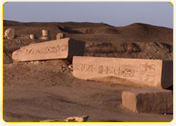
The greatest temple
Nowadays it is used by local men for bathing, but foreign female visitors will not be denied entry. It was formerly used by local brides for bathing, but that practice has now moved to the nearby Tamusi bath, which is more secluded.
Cleopatra’s Pool has a little cafe, sheltered from the sun and good for hot days.
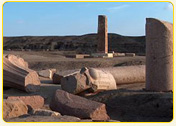
Luxour - Hatshepsut
Hatshepsut is the only woman ruling Egypt as a pharaoh, but this only happened through clever use of coalitions and marriage. She was the daughter of Tuthmosis 2, married to Tuthmosis 3 and after his death she claimed effective power by marrying infant Tuthmosis 4. Her temple here at the foot of the Theban hills is among the most effectively designed structures of all of Egypt. While employing most of the grand effects of common temples, this temple makes use of open space and contrasts with nature. Most of the area is based upon the experience of the arrival. Wide columned halls are put on top of each others, with two ramps bringing you up to the 2nd floor, which is deliberately dwarfed by the huge hills in the back. But the temple almost continues into the hills, and the hills are not just any hills. It is the other side of the Valley of Kings, the place where kings built tombs in the form of shafts connecting to the underworld.
In modern times enough of the temple remains to impress visitors and help even the most insecure photographer to make fine shots. But there are two important parts gone, and you should allow yourself a moment or two to try to imagine how things may have looked.

Luxour - Karnak
Temple of Mentu
The Temple of Mentu is seriously closed to visitors, but with a promise of not entering you will possibly be allowed to take it in from the top of the mound diving it from the Precinct of Amon. There is not very much to see, but the gate is in excellent condition.
The Temple of Mentu was not a lone temple, and within what seems like one structure there were also small temples dedicated to Amon, Harpre and Osiris.
The Temple of Mentu was built by the command of Amenophis 3 of the 18th Dynasty (15th century BCE) and some of his cartouches have survived.
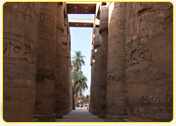
Cities - Abu Sir
5th Dynasty Pyramids
The complex at Abu Sir is a necropolis from the 5. Dynasty, and was in use for a fairly short period of time, just about 70 years.
The importance of the area may have started sometime after 2500 BCE, and ended before 2420 BCE.
Younger than the pyramids of Giza, one gets surprised by the fact that they are so much smaller.
All in all there are 3 standing pyramids, plus the remains of a handful other. The Pyramid of Neferikareis the largest, with its height of 72M.
The name Abu Sir comes from the Egyptian”Per Wsir”, which meant “Place ofOsiris”.
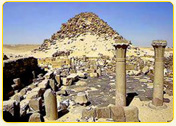
Cities - Dendera
Temple of Hathor
The temple at Dendera, dedicated to Hathor, belongs to the Ptolemaic era of Egypt. This was a time of foreign rulers, but who adopted Egyptian culture and religion. Yet, there were changes with this and contemporary temples, compared to temples built more than a 1000 years earlier.
The temple of Hathor at Dendera was built between 125 BCE and 65 CE belonging to the Greaco-Roman period. It is therefore more a continuation of the original Egyptian culture, than a part of it. Dendera had since long been a cult centre, also then with the goddess of joy, Hathor, as the central deity. The Birth House of Nectanebo is 200 years older than the temple.
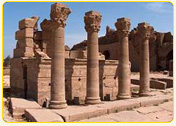
Cities - Kom Ombo
Twin Temple
Kom Ombo used to be an important caravan town – it was here that the 40 days caravans from Sudan or Nubia met the caravans carrying gold from the mines in the eastern desert. In Ptolemaic times (from the 3rd century BCE until early 1st century CE) Kom Ombo was the training ground for army elephants.
Today only a small town remains, noted for its sugar production and the many Nubians who settled here after their villages were inundated by the Aswan High Dam in the 1960’s.
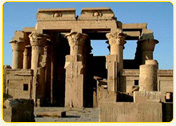
Cities - Philae
Saved from the waters
The Temple of Isis or the other temples, is no longer at the island of Philea, which was inundated by the Aswan Dams, partly from 1902, completely from the 1960s. But with the help of UNESCO all the monuments were transported to the nearby island of Aglika, 500 away.
The Philae temples have a tradition of being one of Egypt’s foremost tourist attractions. The oldest structures date back to 4th century BC, built there are elements from Ptolemaic, Roman, Christian and Muslim eras. The Temple of Isis was built in the Ptolemaic period (332-330 BC), and was the foremost sanctity of the popular cult of Isis and Osiris, a cult that was a strong contender to early Christianity.
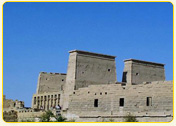
Cities - Abu Simbel
The frightening temple
The isolation of the temple of Abu Simbel is part of the reason for its existence. Here, on the point where Nubiaends and Egypt begins, Pharaoh Ramses 2 decided abour 3,300 years ago to erect a temple with a shape and dimensions that should frighten invaders from the south.
Four 20M high statues of himself stare towards any possible invader from the south, telling them what power they will face if they continue north.
For the brave who should dare to enter, large wall decorations show how Ramses kills Hittites, Nubians and Libyans — the main enemies of Egypt in those days
The temple was officially erected in veneration of the major gods of Amon and Re-Harakhte, but Ramses was an unusually immodest Pharaoh, and if anything, this temple tries to indicate that he himself is larger than any god.
It might be considered a logical breach, but his claim to divinity is granted by the gods he immediately overshadows.

